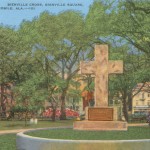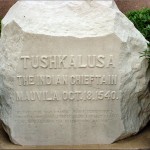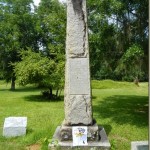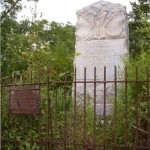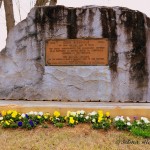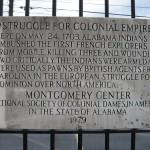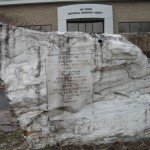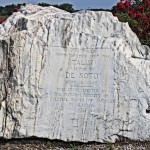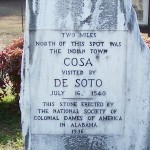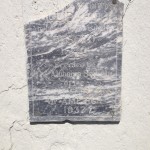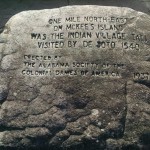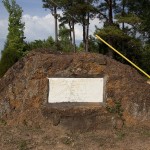The Historical Activities Committee works in the fields of research, preservation, restoration and education according to the Objects of The Society, which are to collect and preserve manuscripts, traditions, relics, and mementos of bygone days; to preserve and restore buildings connected with the early history of our country; to educate our fellow citizens and ourselves in our country’s history and thus diffuse healthful and intelligent information concerning the past; to create a popular interest in our colonial history; to stimulate a spirit of patriotism and a genuine love of country; and to impress upon the young the sacred obligation of honoring the memory of those heroic ancestors whose ability, valor, sufferings and achievements are beyond all praise.
HISTORIC MARKERS IN ALABAMA
The National Society of The Colonial Dames of America in The State of Alabama has a long history of placing historic markers commemorating significant events in the state’s history. The following memorials have been erected by the Society since its organization:
- 1906: In Bienville Square, Mobile, a massive stone cross in honor of Jean Baptiste Le Moyne, Sieur de Bienville, Governor of Louisiana and founder of its first permanent capitol, Mobile, 1711.
- 1908: A boulder in Tuscaloosa honoring Tushkalusa, Indian Chief, October 18, 1540.
- 1912: A monument at Fort Toulouse, a French Fort built by Bienville in 1714.
- 1912: A Lunette window in the YMCA in Mobile.
- 1915: A monument marking the site of Fort Tombecbe, a French settlement in Sumter County, 1735.
- 1917: Mounted and placed in Bienville Square, Mobile, two cannons, one from Fort Condé (1711 – 1763) and the other from Fort Charlotte (1763 – 1780). These cannons were removed in 1963 to the grounds of our Museum House on the site of the original Fort, first Condé, then Charlotte.
- 1932: A boulder to commemorate a meeting in 1714 between Bienville, the governor of the Province, and the Alibamo Indians, which occurred on the high bluff overlooking the present day Selma.
- 1979: A plaque to commemorate the Indian ambush of French explorers in Montgomery on May 24, 1703.
In addition, they have placed six markers tracing DeSoto’s Trail through the state:
- 1930: A boulder to mark the site of the Indian town of Tawasa, visited by DeSoto September 5 – 13, 1540. This is at Maxwell AFB in Montgomery.
- 1936: A boulder commemorating DeSoto’s visit to the Indian village of Talisi, September 18, 1540. This is near Childersburg.
- 1937: A boulder commemorating DeSoto’s visit to the Indian village of Ullibakali in 1540. This is at Mt. Meigs.
- 1937: A large stone marker commemorating the visit of DeSoto, 1540, to the Indian village of Toli on McKee’s Island, near Guntersville.
- 1939: A boulder marking the site of the Indian village of Piache, visited by DeSoto in 1540. This is at Claiborne, where LaFayette was entertained in 1825.
- 1906: In Bienville Square, Mobile, a massive stone cross in honor of Jean Baptiste Le Moyne, Sieur de Bienville, Governor of Louisiana and founder of its first permanent capitol, Mobile, 1711.
- 1908: Boulder in Tuscaloosa honoring Tushkalusa, Indian Chief, October 18, 1540.
- 1912: Monument at Fort Toulouse, French Fort, built by Bienville in 1714.
- 1915: Monument marking the site of Fort Tombecbe, a French settlement in Sumter County 1735. This marker is on the bank of the Tombigbee River at Epes, Alabama.
- 1932: A boulder to commemorate a meeting in 1714 between Bienville, the governor of the Province, and the Alibamo Indians, which occurred on the high bluff overlooking the present day Selma.
- 1979: A plaque to commemorate the Indian ambush of French explorers on May 24, 1703, Montgomery, Alabama.
- 1930: A boulder to mark the site of the Indian town of Tawasa, visited by DeSoto September 5 – 13, 1540. This is at Maxwell AFB in Montgomery, Alabama.
- 1936: A boulder commemorating DeSoto’s visit to the Indian village of Talisi, September 18, 1540. This is near Childersburg, Alabama.
- 1936: A boulder commemorating DeSoto’s visit to the Indian village of Talisi, September 18, 1540. This is near Childersburg, Alabama.
- 1937: A plaque commemorating DeSoto’s visit to the Indian village of Ullibakali in 1540, at Mount Meigs just east of Montgomery.
- 1937: A large stone marker commemorating the visit of DeSoto to the Indian village of Toli, on McKee’s Island near Guntersville, in 1540
- 1939: A boulder marking the site of the Indian village of Piache, visited by DeSoto in 1540. Fort Claiborne was also erected here in 1813 and visited by LaFayette in 1825.


